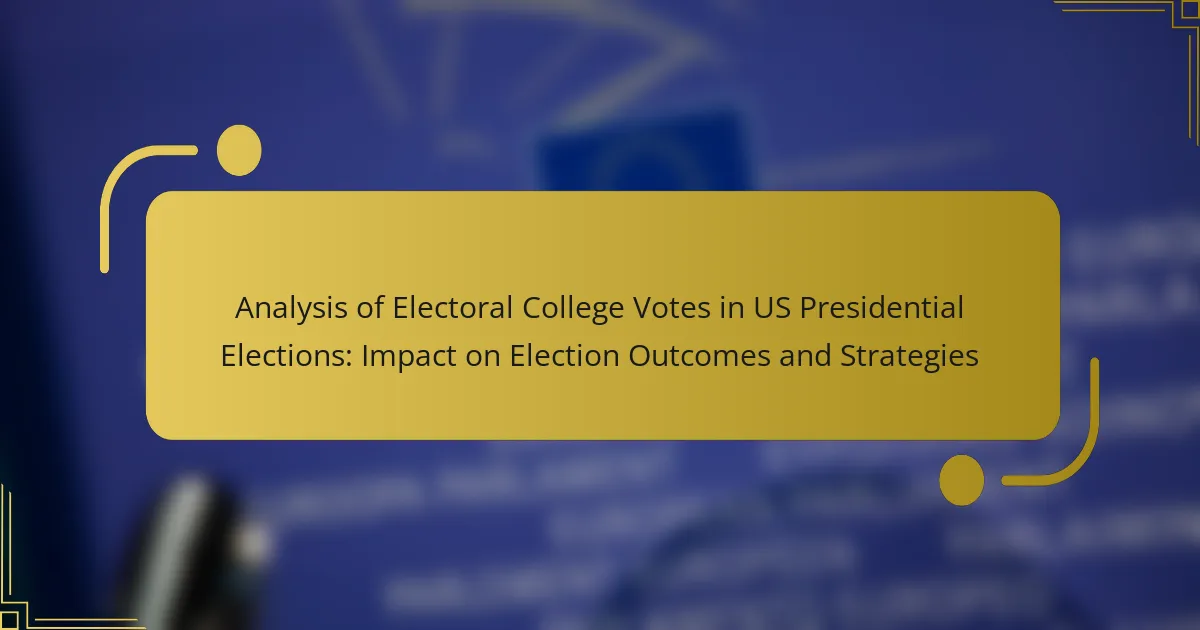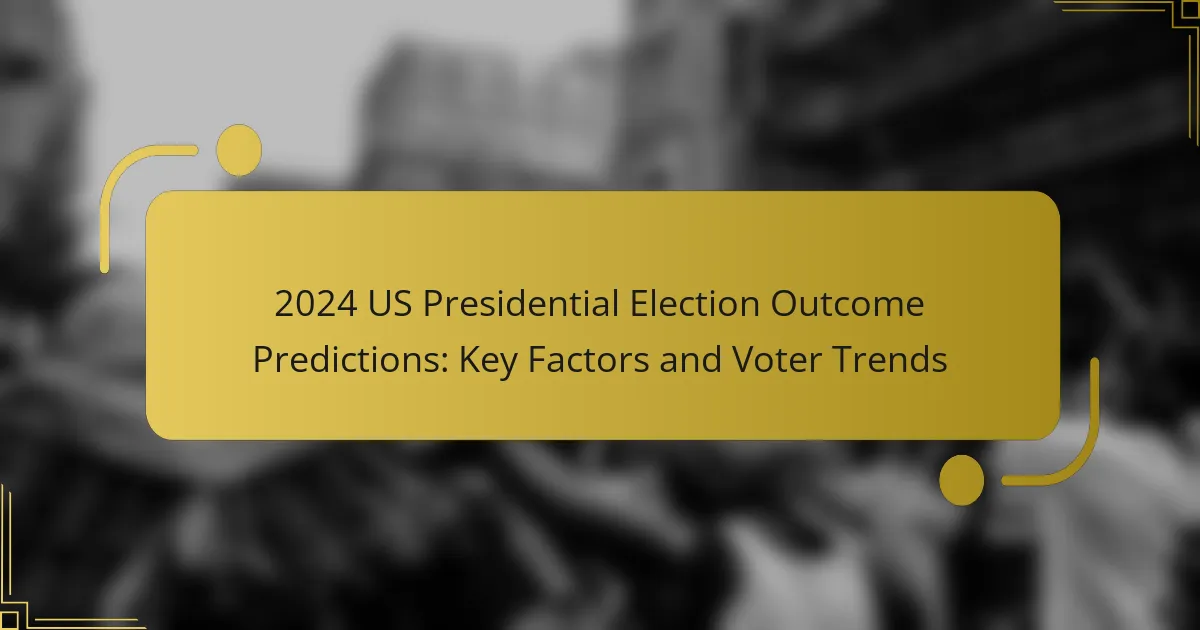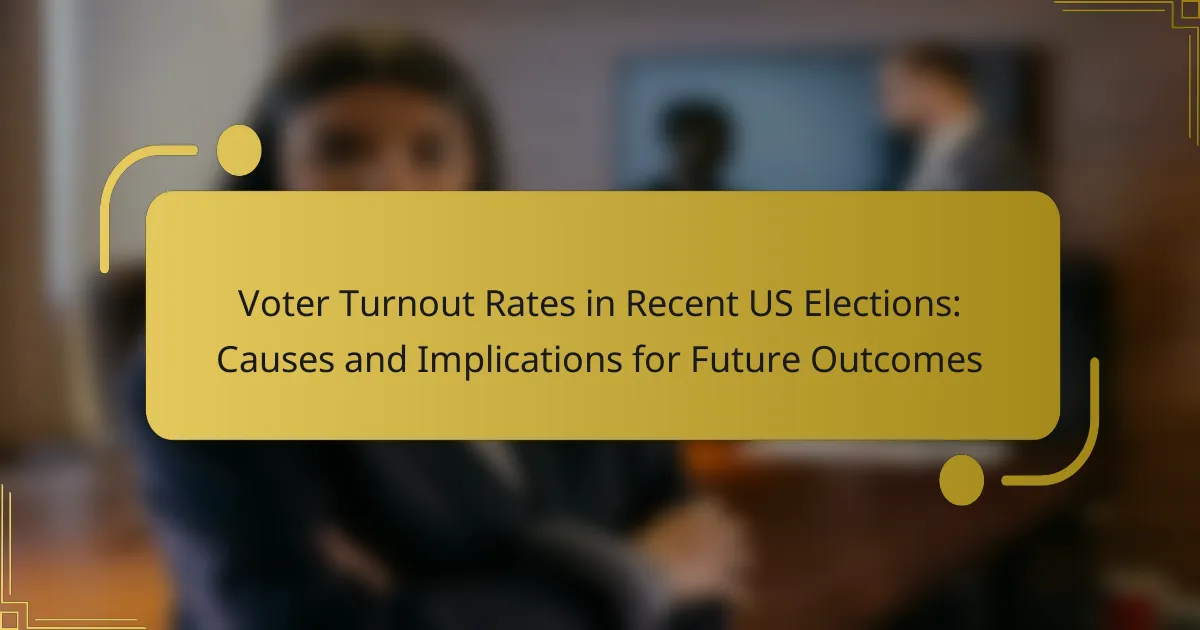The Electoral College is a constitutional mechanism for electing the President and Vice President of the United States, comprising 538 electors with a majority of 270 needed to win. Each state’s electoral votes are determined by its congressional representation, leading to a system where populous states have more influence. This structure allows for the possibility of a candidate winning the presidency without securing the popular vote, as evidenced in several historical elections. The article examines how the Electoral College impacts election outcomes and campaign strategies, highlighting the significance of swing states and targeted voter outreach in the electoral process. Key strategies used by candidates include focusing resources on battleground states and addressing specific voter concerns to maximize electoral support.
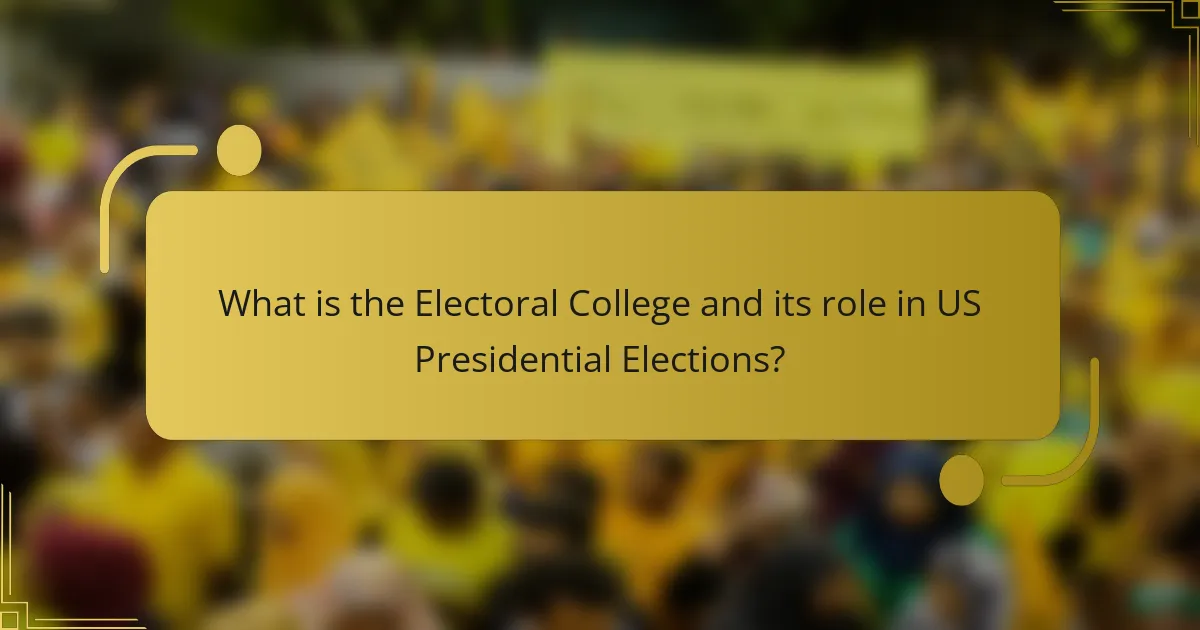
What is the Electoral College and its role in US Presidential Elections?
The Electoral College is a mechanism established by the U.S. Constitution for electing the President and Vice President. It consists of 538 electors, with a majority of 270 needed to win the presidency. Each state is allocated a number of electors based on its representation in Congress. This means that states with larger populations have more electoral votes. During the presidential election, citizens cast their votes for a slate of electors pledged to their chosen candidate. These electors then formally cast their votes for President and Vice President in December. The system was designed to balance the influence of populous states with less populous ones. This can result in a candidate winning the presidency without winning the popular vote, as seen in the elections of 1824, 1876, 1888, 2000, and 2016. The Electoral College plays a critical role in shaping campaign strategies, as candidates focus on swing states where the outcome is uncertain.
How is the Electoral College structured?
The Electoral College is structured as a body of electors established by the United States Constitution. It consists of 538 electors, with each state allocated a number of electors equal to its total number of Senators and Representatives in Congress. There are 100 Senators and 435 Representatives, plus 3 electors for the District of Columbia. Each state conducts a popular vote to select its electors during the presidential election. Most states use a winner-takes-all system, where the candidate receiving the majority of votes in that state gets all its electoral votes. The candidate must receive a majority of electoral votes, at least 270, to win the presidency. This structure was created to balance the influence of populous states with less populous ones in presidential elections.
What are the key components of the Electoral College?
The key components of the Electoral College are electors, the voting process, and allocation of votes. Electors are individuals appointed by each state to cast votes for president and vice president. Each state has a number of electors equal to its total congressional representation, which includes both senators and representatives. The voting process occurs during the presidential election, where citizens cast their votes, which determine the electors’ choices. Most states use a winner-takes-all system, where the candidate receiving the majority of votes gets all of that state’s electoral votes. The total number of electoral votes is 538, and a candidate needs a majority of 270 to win the presidency. This system was established by the U.S. Constitution in Article II, Section 1.
How does the allocation of electoral votes work?
Electoral votes are allocated based on the population of each state. Each state receives a number of electoral votes equal to its total number of Senators and Representatives in Congress. There are 538 electoral votes in total. A candidate needs a majority of 270 electoral votes to win the presidency. States with larger populations have more electoral votes. For example, California has 55 electoral votes, while Wyoming has 3. The allocation of these votes can affect campaign strategies. Candidates often focus on swing states, where electoral votes are less predictable. This allocation system emphasizes the importance of both population and state representation in U.S. presidential elections.
Why was the Electoral College established?
The Electoral College was established to balance the influence of populous states with less populous ones in presidential elections. It was created by the Founding Fathers during the Constitutional Convention of 1787. The system aimed to ensure that all regions of the country had a voice in the selection of the president. Each state is allocated a number of electors based on its congressional representation. This arrangement encourages candidates to campaign in a variety of states, not just those with large populations. The Electoral College was also a compromise between direct popular elections and congressional selection of the president. This system is outlined in Article II of the U.S. Constitution. It has been used in every presidential election since 1788.
What historical factors influenced the creation of the Electoral College?
The creation of the Electoral College was influenced by historical factors such as the framers’ concerns about direct democracy. They feared that direct popular elections could lead to mob rule. The compromise between populous and less populous states was also significant. Smaller states wanted to ensure their influence in presidential elections. The framers aimed to balance power between states and the federal government. This system was established in the U.S. Constitution in 1787. The method of electing the president was a reflection of the political context of the time. It aimed to address regional interests and promote national unity.
How has the purpose of the Electoral College evolved over time?
The purpose of the Electoral College has evolved from a compromise between direct popular vote and congressional selection to a mechanism reflecting the popular vote in presidential elections. Initially, the framers of the Constitution established the Electoral College to balance the influence of populous states with less populous ones. Over time, the Electoral College became a means for states to allocate their electoral votes based on popular vote outcomes. This shift was solidified by the introduction of winner-takes-all systems in most states during the 19th century. Consequently, the Electoral College now emphasizes the importance of swing states in presidential campaigns. This evolution reflects a growing alignment with democratic principles while maintaining federalism. The impact of this system has shaped election strategies, focusing candidates’ efforts on key battleground states.
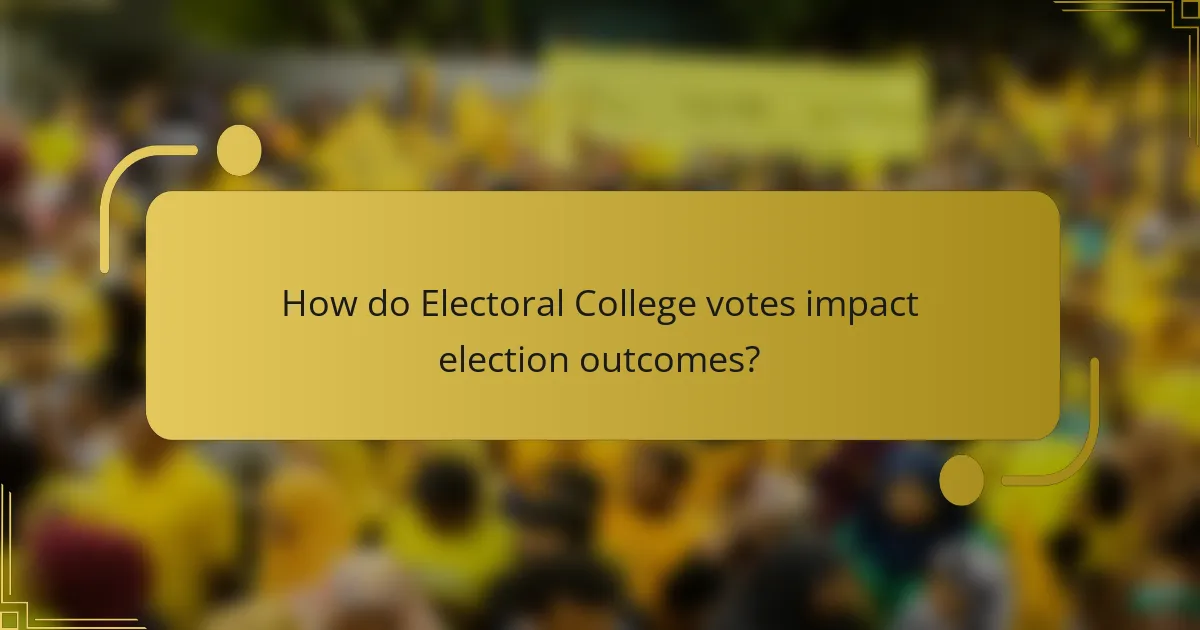
How do Electoral College votes impact election outcomes?
Electoral College votes directly determine the outcome of U.S. presidential elections. Each state has a specific number of electoral votes based on its population. A candidate needs a majority of these votes, specifically 270 out of 538, to win the presidency. The winner-takes-all system in most states means that the candidate receiving the most votes in a state gets all its electoral votes. This can lead to scenarios where a candidate wins the presidency without winning the popular vote. For example, in 2000, George W. Bush lost the popular vote but won the Electoral College. Thus, the distribution of electoral votes can significantly influence campaign strategies and voter mobilization efforts.
What are the implications of winning electoral votes?
Winning electoral votes directly determines the outcome of a U.S. presidential election. The candidate who secures a majority of these votes, currently set at 270, becomes the president. This system incentivizes candidates to focus on swing states, where electoral votes can be won or lost. Winning electoral votes also influences campaign strategies, resource allocation, and voter mobilization efforts. Historical examples show that candidates often tailor their messages to resonate with the demographics of key states. Furthermore, winning electoral votes can shape the political landscape by impacting party control in Congress. Overall, the implications of winning electoral votes extend beyond the election itself, influencing governance and policy direction.
How do electoral votes affect the overall election strategy of candidates?
Electoral votes significantly influence the overall election strategy of candidates. Candidates focus on winning states with a high number of electoral votes. This is because the Electoral College system awards votes based on state populations. For example, California has 55 electoral votes, making it a key target for candidates.
Candidates often prioritize swing states, which can vote for either party. These states, like Florida and Ohio, have a substantial number of electoral votes. Winning these states can be crucial for securing the presidency.
Campaign strategies may include tailored messaging to resonate with local voters. Candidates also allocate resources, such as time and funding, to these critical areas. Historical trends show that candidates who effectively target electoral vote-rich states tend to perform better.
In the 2020 election, Joe Biden focused heavily on battleground states, contributing to his victory. This demonstrates the importance of electoral votes in shaping campaign strategies.
What are some notable examples of elections decided by the Electoral College?
The Electoral College has decided several notable elections in U.S. history. One significant example is the 1824 election. John Quincy Adams won despite losing the popular vote to Andrew Jackson. The decision was made by the House of Representatives after no candidate secured a majority in the Electoral College.
Another example is the 1876 election. Rutherford B. Hayes lost the popular vote to Samuel J. Tilden. However, Hayes won the presidency after a controversial compromise that awarded him the necessary electoral votes.
The 2000 election is also notable. George W. Bush lost the popular vote to Al Gore but won the presidency by securing a majority of Electoral College votes. The Supreme Court’s decision in Bush v. Gore effectively decided the election.
Lastly, the 2016 election saw Donald Trump win the presidency despite losing the popular vote to Hillary Clinton. Trump garnered 304 electoral votes while Clinton received 227. These examples illustrate the complexities and implications of the Electoral College in determining U.S. presidential elections.
Why do some critics argue against the Electoral College?
Critics argue against the Electoral College because it can undermine the principle of one person, one vote. This system allows for a candidate to win the presidency without winning the popular vote. For example, in 2000 and 2016, candidates lost the popular vote but secured the presidency through the Electoral College. Critics claim this leads to unequal representation across states. Smaller states have disproportionately higher influence relative to their population size. Additionally, the winner-takes-all approach in most states can discourage voter turnout. Many voters in heavily partisan states feel their votes do not matter. This has raised concerns about the legitimacy of election outcomes.
What are the main arguments for abolishing the Electoral College?
The main arguments for abolishing the Electoral College include its potential to disenfranchise voters. The system can lead to situations where candidates focus on a few swing states, ignoring the majority. This creates unequal representation, as votes in less populous states carry more weight. Additionally, the Electoral College can result in a president winning without the popular vote, as seen in the elections of 1824, 1876, 1888, 2000, and 2016. Critics argue that this undermines democratic principles. Furthermore, it perpetuates a two-party system, limiting voter choice. Overall, these factors contribute to calls for reform or abolition of the Electoral College.
How do alternative voting systems compare to the Electoral College?
Alternative voting systems differ significantly from the Electoral College. The Electoral College allocates votes based on state representation, often leading to a winner-takes-all scenario. In contrast, alternative systems like ranked-choice voting allow voters to rank candidates, promoting broader representation.
Alternative systems can reduce the impact of gerrymandering, as they do not rely on district boundaries. Research indicates that ranked-choice voting can lead to more diverse candidates being elected. For example, Maine’s implementation of ranked-choice voting in 2018 resulted in increased participation among independent candidates.
The Electoral College can result in a disparity between the popular vote and the final election outcome. In 2000 and 2016, candidates won the presidency without winning the popular vote. This contrasts with alternative systems, which typically reflect the voters’ preferences more accurately.
Overall, alternative voting systems promote inclusivity and better representation compared to the Electoral College.
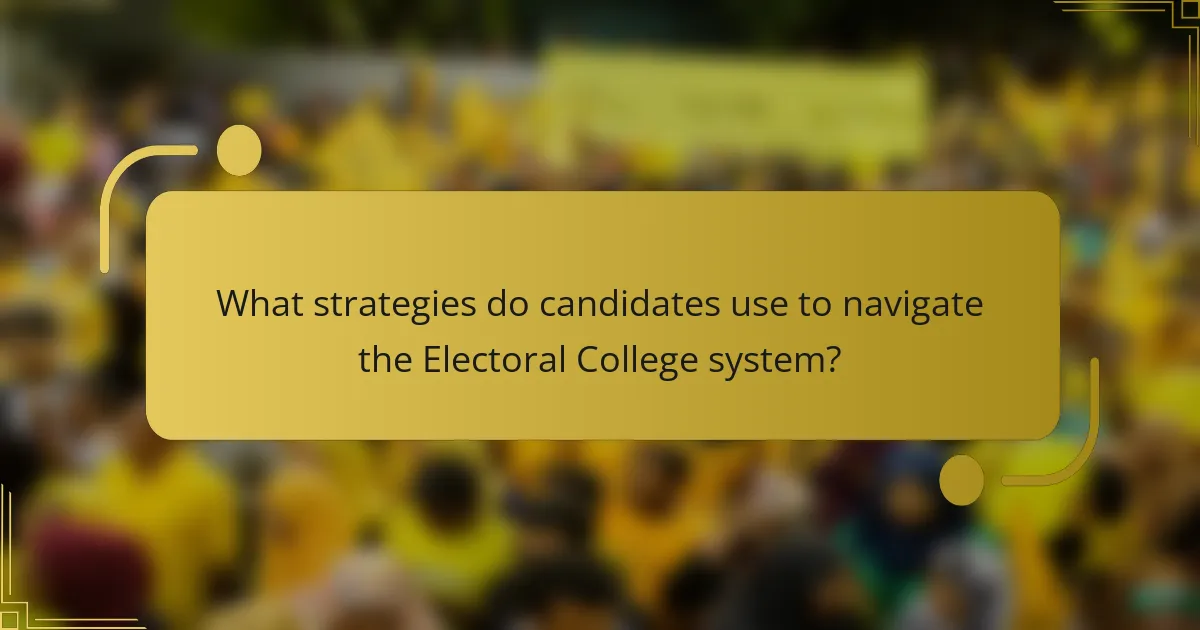
What strategies do candidates use to navigate the Electoral College system?
Candidates use several strategies to navigate the Electoral College system effectively. They focus on winning battleground states where the electoral votes are competitive. Candidates often tailor their campaign messages to resonate with the demographics and issues important to voters in these states. Additionally, they allocate resources such as time and funding to these key regions to maximize their impact.
Candidates also build coalitions with local organizations to enhance their outreach efforts. They may engage in targeted advertising to influence undecided voters. Furthermore, candidates often emphasize issues that align with the interests of specific states, thereby increasing their appeal.
Historical data shows that winning a combination of swing states can significantly influence overall electoral outcomes. For instance, in the 2020 election, Joe Biden’s focus on states like Pennsylvania and Michigan proved pivotal for his victory. These strategies demonstrate how candidates navigate the complexities of the Electoral College system to secure the necessary votes for election.
How do candidates prioritize states in their campaigns?
Candidates prioritize states in their campaigns based on electoral vote significance. States with a higher number of electoral votes receive more attention. For example, California and Texas are prioritized due to their large electoral counts. Swing states are also critical, as they can change outcomes. States like Florida and Pennsylvania often receive focused campaign efforts. Candidates analyze polling data and demographics to identify key states. They invest resources in states where they have the best chance of winning. This strategic approach increases their likelihood of securing the necessary electoral votes.
What factors influence a candidate’s focus on specific states?
Candidates focus on specific states due to several key factors. These include the number of electoral votes each state holds. States with larger electoral votes, like California and Texas, attract more attention. Swing states also play a crucial role. Candidates prioritize states that can easily switch party allegiance, such as Florida and Pennsylvania. Demographic trends influence candidate strategies as well. Understanding the voter composition helps tailor campaign messages. Additionally, local issues matter significantly. Candidates often address concerns that resonate with state residents. Finally, campaign resources dictate focus areas. Budget constraints can limit a candidate’s ability to engage in multiple states simultaneously.
How do swing states play a crucial role in electoral strategies?
Swing states are pivotal in electoral strategies because they can be won by either major political party in an election. Their unpredictable voting patterns make them essential for candidates seeking to secure the necessary Electoral College votes. For instance, states like Florida and Ohio have historically played critical roles in determining the outcome of presidential elections. In the 2020 election, Joe Biden focused heavily on swing states, winning crucial votes in Pennsylvania and Michigan. Candidates allocate significant resources, including campaign visits and advertising, to these states. The goal is to sway undecided voters who can tip the balance in a close race. Data shows that swing states often receive more attention than solidly partisan states. This strategic focus can influence voter turnout and overall election results.
What are the best practices for mobilizing voters in the Electoral College framework?
Best practices for mobilizing voters in the Electoral College framework include targeted outreach, education on the voting process, and leveraging grassroots campaigns. Targeted outreach focuses on key demographics in battleground states. Education on the voting process ensures voters understand how their votes impact the Electoral College. Grassroots campaigns engage communities through local events and social media. Research shows that personalized communication increases voter turnout. A study by the Pew Research Center found that informed voters are more likely to participate in elections. These strategies effectively enhance voter mobilization efforts within the Electoral College system.
How can candidates effectively engage with voters in key states?
Candidates can effectively engage with voters in key states by utilizing targeted outreach strategies. These strategies include door-to-door canvassing, which allows candidates to connect personally with constituents. Additionally, hosting town hall meetings fosters direct dialogue between candidates and voters. Social media campaigns can amplify messages and reach diverse demographics quickly. Tailoring messaging to local issues resonates more with voters. Data analytics can identify key voter segments and their preferences. Research shows that personalized communication increases voter engagement significantly. For example, candidates who focus on local concerns tend to see higher turnout rates in targeted areas.
What role does grassroots campaigning play in influencing electoral votes?
Grassroots campaigning significantly influences electoral votes by mobilizing local support and increasing voter turnout. This type of campaigning engages communities directly through personal interactions and local events. It fosters a sense of ownership among voters regarding the electoral process. When voters feel connected to a candidate through grassroots efforts, they are more likely to participate in elections. Historical examples, such as Barack Obama’s 2008 campaign, demonstrated how grassroots organizing can lead to higher turnout in key demographics. In that election, Obama’s campaign registered over 2 million new voters, which contributed to his electoral success. Thus, grassroots campaigning is crucial in shaping electoral outcomes by enhancing voter engagement and turnout.
What practical tips can candidates employ to maximize their Electoral College votes?
Candidates can maximize their Electoral College votes by focusing on swing states. Swing states often determine election outcomes due to their unpredictable voting patterns. Candidates should prioritize campaigning in these states to gain crucial electoral votes. Targeted advertising and grassroots outreach can effectively sway undecided voters. Understanding local issues and tailoring messages to resonate with constituents is essential. Building coalitions with local leaders can enhance credibility and reach. Additionally, candidates should leverage data analytics to identify voter demographics and preferences in these states. Historical data shows that candidates who invest in swing states often secure more electoral votes. For instance, in the 2020 election, Joe Biden’s focus on key swing states significantly contributed to his victory.
The main entity of this article is the Electoral College, a constitutional mechanism for electing the President and Vice President of the United States. The article provides a comprehensive analysis of the Electoral College’s structure, its historical context, and the implications of its voting system on election outcomes. It explores how electoral votes are allocated, the strategies candidates use to navigate this system, and the role of swing states in shaping campaign efforts. Additionally, it addresses criticisms of the Electoral College and discusses best practices for mobilizing voters within this framework, ultimately highlighting the significance of electoral votes in determining presidential elections.
